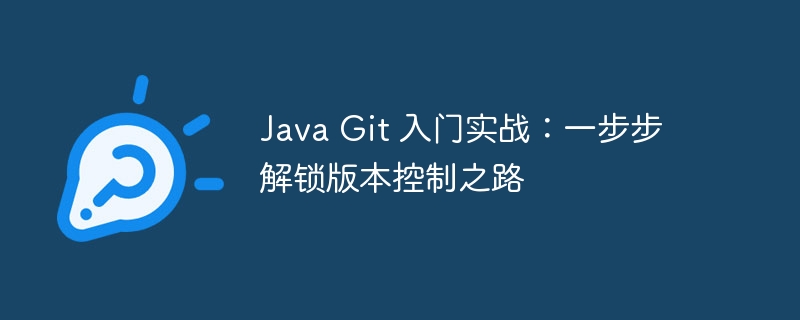Home >Java >javaTutorial >Getting Started with Java Git: Unlocking Version Control Step by Step
Getting Started with Java Git: Unlocking Version Control Step by Step
- PHPzforward
- 2024-03-05 20:37:221254browse

Get started with Java Git: Unlock the road to version control step by step Version control is an essential skill for programmers. As one of the most popular version control tools currently, Git is a skill that every developer must master. This article is carefully written by PHP editor Strawberry. It will lead readers to gradually learn the basic concepts, common commands and practical operations of Git, helping readers easily get started with Git and master the essence of version control. Let's embark on the road of Git version control together, improve programming skills, standardize team collaboration, and improve work efficiency!
git is a distributed version control system, which means that each developer has a complete copy of the code base and can work independently Commitment and version management. It allows team members to make changes locally and then easily share and collaborate with others.
Install Git
Before you start using Git, you need to install it on your system. You can download and install the corresponding version from the Git official website. For Java developers, Git can also be integrated through IDEs such as IntelliJ idea.
Basic command line operations
The basic operations of Git are performed through the command line. Here are a few common commands:
git init:初始化一个新的 Git 仓库 git add:将文件添加到暂存区 git commit:将暂存区中的更改提交到本地仓库 git status:显示当前的 Git 状态 git log:查看提交历史记录
IntelliJ IDEA integration
If you use IntelliJ IDEA, you can easily integrate Git. Under the VCS tab, you can access all features of Git, including committing, pulling, and pushing changes.
work process
1. Clone the repository
To start working with Git, you first need to clone an existing repository. Use the following command:
git clone https://GitHub.com/username/repository.git
This will create a local copy containing all files and history of the repository.
2. Add and commit changes
After making any changes to the local copy, you can use the git add command to add them to the staging area. Then use the git commit command to commit the changes to the local repository.
3. Push changes
To share your changes with others, you need to push them to the remote repository. Use the following command:
git push origin master
This will commit your changes to the master branch of the remote repository.
4. Pull changes
To get the changes made by others, you need to pull the changes from the remote warehouse. Use the following command:
git pull origin master
This will merge the changes from the remote repository into your local repository.
Branch and merge
Branching allows you to create different versions of your code base for development in parallel. You can create and merge branches using the following commands:
git checkout -b new-branch git merge new-branch
Conflict resolution
When multiple people make changes to the same file at the same time, conflicts may occur. Git will highlight conflicts and prompt you to resolve them manually. You can use a text editor or Git command line tools to resolve conflicts.
Best Practices
- Commit changes frequently to avoid losing data.
- Use descriptive commit messages to clearly document changes.
- Regularly pull and merge changes to keep the warehouse up to date.
- Use branches to isolate changes and avoid conflicts.
in conclusion
Mastering Git is an essential skill for modern Java developers. By following the steps in this article, you will be able to start using Git to manage code, improve team collaboration efficiency and code quality. Keep practicing and exploring Git's advanced features to take advantage of its powerful version control capabilities.
The above is the detailed content of Getting Started with Java Git: Unlocking Version Control Step by Step. For more information, please follow other related articles on the PHP Chinese website!
Related articles
See more- Detailed graphic and text explanation of Java Web project created using IntelliJ IDEA 15 and Maven
- How to configure natural language processing using IntelliJ IDEA on Linux systems
- A comprehensive guide to parsing Maven local repository configuration
- Maven local warehouse configuration guide
- Optimize Maven local warehouse configuration: speed up project construction

